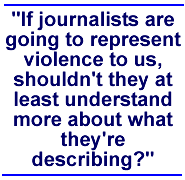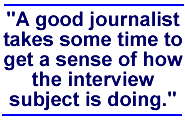
Part Four - The Media Have a Role in the Chain of Violence
Simpson is aware of the impact that intense media focus on traumatic events has on both survivors and journalists. He has invited reporters to participate in classes at the UW, and he recalls a fellow faculty member who was initially skeptical of the role-playing students took part in to practice their interviewing skills with trauma victims.
"Then the reporter talked about a police shooting of a drug suspect that he'd witnessed," Simpson says. "He told about having emotional problems afterward. He'd get angry and have trouble sleeping. Eventually, police officers he knew noticed how irascible he was being and suggested he see the police psychologist. The reporter did so and realized how much seeing a death—being the man's last civilian eyewitness—had affected him."

Simpson, Scherer and their colleagues have conducted workshops, both in Seattle and around the country, in an effort to raise the standard of reporting on trauma and to help journalists understand the impact their jobs has on their own emotional well-being.
"We're trying to encourage more humane practices," Simpson explains. "If journalists are going to represent violence to us, shouldn't they at least understand more about what they're describing? Why should they be naïve or ignorant about the effects of violence?"
Simpson is also giving students training that was missing from his own undergraduate education as a journalism student at the UW in the 1950s. Every UW journalism major now receives a trauma orientation, takes an ethics class and may take another in crisis communication.
"The students have been comfortable and receptive to this part of their training," Simpson says. "We have faith that when they get into the field they'll be more knowledgeable about trauma and write more sensitive stories as a result."
Though time pressure, competition from rival journalists, and a lack of preparation can mitigate against a reporter's showing this sensitivity in the immediate aftermath of violence, Simpson feels that there are steps a reporter can take to do a better job under these circumstances.
"A good journalist takes some time to get a sense of how the interview subject is doing," Simpson explains. "Give him or her a sense of control. Tell them who you are, and what you're going to write. The sensitive reporter will talk to a person first, before walking into the home with a camera. Some reporters know this intuitively, and others can benefit from training."

Scherer uses her experience as a trauma victim and her research to help journalists anticipate what they will encounter when they ask to interview survivors and their families.
"Emotional trauma is a physiological event," she says. "Reporters need to understand the effects of emotional trauma and approach the victim with care, even when there's no obvious sign of physical injury."
While journalism programs at other universities include some elements of trauma training in their curricula, the UW's Dart Center plays a unique role in combining teaching, research and outreach to news organizations. The Dart Center has helped begin similar programs at the University of Colorado, University of Central Oklahoma, Indiana University, and Queensland University of Technology in Australia.
The Dart Center also encourages a higher standard of journalism by granting annual fellowships to help reporters study emotional trauma, its effect on victims of disaster and violence, and the implications for news gatherers. The Dart Award for Excellence in Reporting on Victims of Violence is a national competition for a $10,000 prize to recognize a newspaper for its outstanding coverage of victims and their experiences.
The Roanoke Times won the Dart Award in 2000 for a series of articles on the suspicious death of an 18-year-old man arrested and placed in the care of a mental institution. The family's grief and confusion after the death, and an official cover-up, make for compelling reading.

Ochberg, chairman of the Dart Center's executive committee, is cautiously optimistic about the progress that's been made in making journalists more aware of the impact of trauma on victims and themselves.
"The media have a role in the chain of violence," he says. "Their reports sometimes focus on the most alluring elements of violation. We encourage them to search hard for the enlightenment that can come after a person's experience of cruelty. These are the stories that should be told. Don't hurt someone who's already been hurt—there's a way to give a voice to the survivor and tell a story that can help in the healing process."
Simpson, who began his career as a reporter for the Wenatchee World and the Wall Street Journal, is also hopeful about raising the standard for media coverage of violence and its victims.
"We now know that many journalists have been affected by years of reporting on trauma," he says. "They may avoid assignments or stop doing interviews with victims. This is bound to affect the ability to do their jobs.
"I'm optimistic that we can help newsrooms become more humane working environments and that reporters can be more creative in their approach to trauma." —Larry Zalin joined the Dart Center for Journalism and Trauma last summer after serving for 10 years as media relations coordinator at Harborview Medical Center.
Go To: Page 1 | Page 2 | Page 3 | Page 4
- Sidebar: Living—and Dying—with the Media
- Return to March 2001 Table of Contents